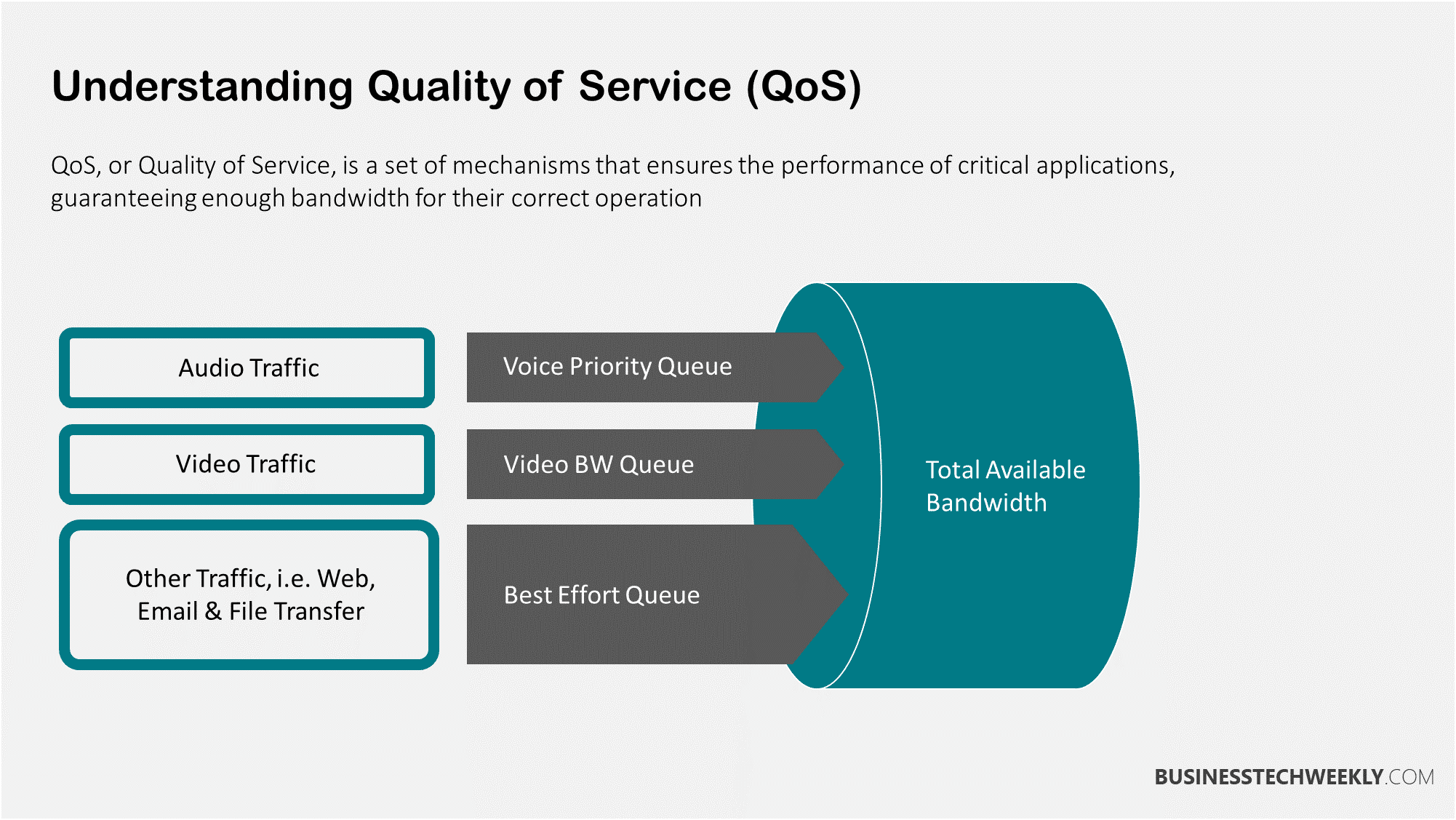What is QoS? Understanding Quality of Service in Computer Networks

The application of Quality of Service, QoS, in computer networks enables businesses to deliver reliable services with minimal disruption to users. The increasing number of devices and applications on the market combined with the rise of social media has brought about a flood in network traffic.
Such network overload can often create discrepancies in performance, leaving organizations with problems like broken images, interrupted video conferencing, poor audio quality, dropped phone calls, and delays, damaging the efficiency in the workplace.
This is where Quality of Service policies and monitoring tools come into play. Below, we explore the basics of QoS and discuss why it is important, how it works and how it can improve user experience.
On this page:
What is QoS?
In general, QoS or Quality of Service is a measurement of the overall performance of a service such as a computer network, telephony, or cloud computing. QoS in networking refers to the technology used to manage traffic passing through the network and ensure the performance of critical applications. The main goal of a QoS policy is to reduce interference like jitter, packet loss, and latency in the network.
QoS also sets boundaries and priorities for different categories of data so that critical applications that rely on real-time data get sufficient dedicated bandwidth and priority over others. This technology is generally applied to networks that carry traffic for resource-intensive applications. Some of these include videoconferencing, online gaming, media streaming, and IPTV.

With QoS, businesses can easily optimize the performance of applications running on the network and stay updated on different factors like the packet rate, delay, bit rate, and jitter.
This will let them control how traffic moves on the network and change how data packets are routed to avoid delays. This will also ensure that the business achieves the expected level of service quality and delivers the desired user experience.
Why is QoS Important in Networking?
Traditional business networks functioned as standalone entities. Teleconferences and phone calls were handled by a PSTN network while computers, laptops, servers, and other devices were connected via a data network.
They never crossed each other’s path unless a system used a telephone line to connect to the web. Speed was not a critical consideration as computer networks carried only data.
However, interactive applications transferring audio and video content require high-speed transmission without any delivery speed variations and packet loss. QoS is vital to ensure desired performance of critical applications that demand high bandwidth for carrying real-time traffic.
It helps businesses prevent the delay of sensitive applications to ensure they perform to the expected level. Lost packets, for example, could result in a delay which may deteriorate the quality of a videoconference call.
QoS becomes more and more critical as the network performance requirements change with the increasing number of users. Modern applications and services demand a large amount of bandwidth to cater to the growing expectations of users.
This is why organizations should deploy technologies that guarantee the best service. QoS also becomes increasingly important as the IoT (Internet of Things) continues to mature. For example, machines are used in manufacturing companies to use networking capabilities to deliver real-time updates on issues.
This means any delay could result in costly errors in the system. QoS guarantees that the data stream takes priority in the network so that information can flow as quickly as possible.
How does QoS Work?
To understand how QoS works, it is necessary first to define the types of traffic it can measure. They are:
- Delay – The time taken by a packet to go from source to destination is sometimes affected by a delay occurring during congestion. The packet may wait in a queue before getting transmitted. Businesses can prevent this problem with QoS by creating a priority queue for different traffic types.
- Bandwidth – It refers to the speed a link in the network has. QoS instructs the router on how it should use the bandwidth. It can, for example, help assign varying amounts of bandwidth to different queues for various types of traffic.
- Jitter – When packets in network congestion arrive out of sequence from irregular speed, you probably get a distortion or gap in the audio or video file you are transferring.
- Loss – This is the amount of data lost from packet loss occurring due to congestion in the network. With QoS, organizations can decide which packets should be dropped in such a scenario.
To implement QoS, an organization should start with identifying the types of traffic that use high amounts of bandwidth, are significant to the business, or are sensitive to packet loss and latency. This will help the entity understand the significance and demands of each type of traffic on the network and develop a suitable approach.
Some businesses, for example, may need to do nothing more than bandwidth management for a few services. In contrast, others may need to completely reconfigure all the services and prioritize queuing for business-critical services.
Tools and techniques for queuing and bandwidth management processes are allocated to roles in the organization to deal with traffic based on the categorization.
This will allow the packets to be stored until they are processed. Priority queuing also helps ensure minimal latency and necessary availability for critical traffic and applications so that the most important activities are not deprived of bandwidth by less important ones.
Techniques Involved in QoS
Businesses can use a wide range of techniques to guarantee desired performance for their most critical applications. Some of these are:
Resource Reservation
Resource Reservation Protocol reserves resources across a network and helps deliver specific QoS levels for data streams. It enables businesses to divide resources among different types of traffic and their origins, guarantee bandwidth and define limits.
Traffic Marking
Once the applications that require priority over others in a network have been identified, you need to mark traffic using processes like DSCP or CoS.
Queuing
This is a process that involves creating policies to provide special treatment to some data streams over others. Queues are like memory buffers where packets are held until they are moved further.
When a packet is given a high priority, it passes to a queue where data is pushed at a higher rate, reducing the chances of getting dropped. The router or switch then moves the packets to the front in the queue for immediate processing.
Traffic Prioritization
Enterprise networks can get overly congested at times, causing switches and routers to start dropping packets because they come in and go out faster than the speed at which they can be processed. Streaming applications suffer as a consequence.
Traffic prioritization enables traffic to be classified and given priority based on the type and destination. This is useful during congestion as high-priority traffic can be easily sent ahead of other traffic.
QoS Advantages
QoS deployment is essential for businesses looking to ensure the availability of critical applications. Let us look at some of the advantages of QoS.
Reduced latency
A delay in network system transactions is a common problem for IT teams. Real-time Transport Protocol packets, when left unclassified, can traverse the network and get treated as ordinary data.
Lack of prioritization can attract adverse consequences, particularly when networks are congested. QoS is essential to avoid latency problems in the network.

Improved security
QoS features the ability to block suspicious or unwanted traffic in the path, working as a firewall to build a highly secure network infrastructure. Powerful security policies also ensure that encrypted packets are given a higher priority, which means safe data streams transmit first.
Better resource management
Quality of Service helps IT teams manage the network resources more efficiently. This results in cost-saving and eliminates the need to invest in link expansion.
Packet loss prevention
Packet loss occurs when data packets are dropped during transit. Packet loss can result from inefficiency or failure, a faulty router, network congestion, poor signal, or loose connection. QoS prioritizes the bandwidth of critical applications to avoid any packet loss.
Enhanced user experience
QoS works to guarantee the high performance of business-critical applications, which ultimately affects the user experience. Employees can enjoy better performance with these applications, helping them improve their efficiency and productivity.

Application prioritization
Quality of Service guarantees that critical applications enjoy better priority and get the resources needed to achieve desired performance.
Traffic management
Regardless of how the traffic travels, managing a network is crucial. Point-to-point traffic ensures organizations can deliver packets from one point to another without any packet loss.
QoS Best Practices
Apart from the techniques, QoS has several best practices that businesses should consider when analyzing their QoS requirements.
- Make sure the maximum bandwidth limits at the source interface
- Minimize the complexity of QoS to get the expected performance level
- Configure traffic prioritization on the basis of type of service or security policy priority
- Look at the ratio of packet distribution between occupied and available queues
Simply implementing QoS policies will not benefit the business. Administrators should configure policies depending on the organization type and customer needs. Selecting a model that suits your network architecture is also essential.
Final Thoughts
QoS is crucial for organizations looking to guarantee the highest performance of their critical services and applications. A company should ensure that high-bandwidth services like streaming services, videoconferencing, and VoIP don’t suffer from any latency.
QoS lets organizations prioritize resources and traffic to get expected performance from an application or service. It also enables prioritizing applications, users, and data flow to guarantee optimum performance levels across the network.


